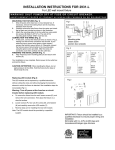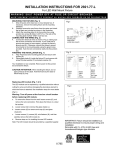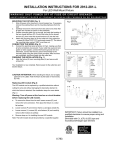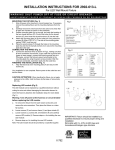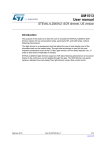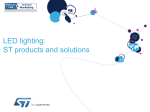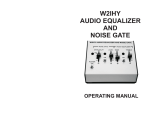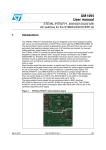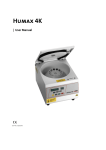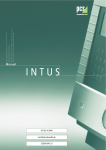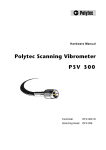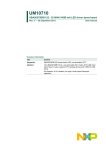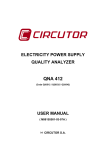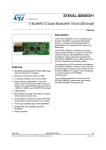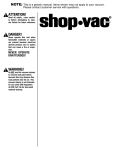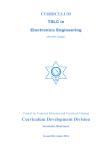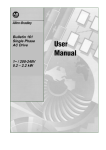Download UM1512 User manual - STMicroelectronics
Transcript
UM1512 User manual STEVAL-ILD003V1: SCR dimmer, EU version Introduction The purpose of this board is to allow the user to evaluate the STEVAL-ILD003V1 SCR (silicon controlled rectifier) dimmer solution to dim low-consumption lamps, particularly CFL and LED lamps, without flickering phenomenon. This light dimmer allows the user to evaluate the SCR dimmer concept by directly testing the dimmable loads on the market today. Through-hole technology is used for the most important components such as the LC filter, gate resistor, turn-on delay capacitor, etc., in order to allow board modifications if needed, to fit particular application requirements. STEVAL-ILD003V1 light dimmers based on SCR allow flickering phenomenon to be solved thanks to the continuous current applied through the gate. The SCR dimmer may easily replace a standard low-cost analog Triac light dimmer using a Diac and potentiometer for its control circuit. February 2013 Doc ID 022738 Rev 2 1/15 www.st.com Contents UM1512 Contents 1 2 3 4 Operating conditions . . . . . . . . . . . . . . . . . . . . . . . . . . . . . . . . . . . . . . . . 4 1.1 Basic features . . . . . . . . . . . . . . . . . . . . . . . . . . . . . . . . . . . . . . . . . . . . . . . 4 1.2 Safety instruction . . . . . . . . . . . . . . . . . . . . . . . . . . . . . . . . . . . . . . . . . . . . 4 Getting started . . . . . . . . . . . . . . . . . . . . . . . . . . . . . . . . . . . . . . . . . . . . . . 6 2.1 Connection diagram . . . . . . . . . . . . . . . . . . . . . . . . . . . . . . . . . . . . . . . . . . 6 2.2 Schematic and board layout . . . . . . . . . . . . . . . . . . . . . . . . . . . . . . . . . . . . 6 Experimental tests and results . . . . . . . . . . . . . . . . . . . . . . . . . . . . . . . . 8 3.1 STEVAL-ILD003V1 SCR dimmer operation with 40 W incandescent lamp 8 3.2 STEVAL-ILD003V1 SCR dimmer working with LED lamp . . . . . . . . . . . . . 9 3.3 Electromagnetic compatibility test . . . . . . . . . . . . . . . . . . . . . . . . . . . . . . . 9 3.3.1 Fast transient voltage immunity . . . . . . . . . . . . . . . . . . . . . . . . . . . . . . . . 9 3.3.2 Radio disturbance compliance according to EN 55015 . . . . . . . . . . . . . 10 Conclusion . . . . . . . . . . . . . . . . . . . . . . . . . . . . . . . . . . . . . . . . . . . . . . . . 11 Appendix A Assembly information . . . . . . . . . . . . . . . . . . . . . . . . . . . . . . . . . . . . 12 A.1 Component assembly layout . . . . . . . . . . . . . . . . . . . . . . . . . . . . . . . . . . . 12 A.2 Bill of materials . . . . . . . . . . . . . . . . . . . . . . . . . . . . . . . . . . . . . . . . . . . . . 12 Revision history . . . . . . . . . . . . . . . . . . . . . . . . . . . . . . . . . . . . . . . . . . . . . . . . . . . . 14 2/15 Doc ID 022738 Rev 2 UM1512 List of figures List of figures Figure 1. Figure 2. Figure 3. Figure 4. Figure 5. Figure 6. Figure 7. Figure 8. Figure 9. Figure 10. Figure 11. Figure 12. Connection diagram . . . . . . . . . . . . . . . . . . . . . . . . . . . . . . . . . . . . . . . . . . . . . . . . . . . . . . . 6 SCR dimmer schematic . . . . . . . . . . . . . . . . . . . . . . . . . . . . . . . . . . . . . . . . . . . . . . . . . . . . 7 SCR dimmer PCB layout . . . . . . . . . . . . . . . . . . . . . . . . . . . . . . . . . . . . . . . . . . . . . . . . . . . 7 SCR dimmer operation for 5 ms turn-on delay . . . . . . . . . . . . . . . . . . . . . . . . . . . . . . . . . . . 8 SCR dimmer operation for 0.5 ms turn-on delay . . . . . . . . . . . . . . . . . . . . . . . . . . . . . . . . . 8 Capacitor discharge voltage after turn-on. . . . . . . . . . . . . . . . . . . . . . . . . . . . . . . . . . . . . . . 8 SCR continuous gate current . . . . . . . . . . . . . . . . . . . . . . . . . . . . . . . . . . . . . . . . . . . . . . . . 8 SCR dimmer operation for 3 ms turn-on delay with LED lamp . . . . . . . . . . . . . . . . . . . . . . . 9 SCR dimmer operation for 7 ms turn-on delay with LED lamp . . . . . . . . . . . . . . . . . . . . . . . 9 SCR dimmer radio disturbance compliance . . . . . . . . . . . . . . . . . . . . . . . . . . . . . . . . . . . . 10 Silkscreen bottom left . . . . . . . . . . . . . . . . . . . . . . . . . . . . . . . . . . . . . . . . . . . . . . . . . . . . . 12 Silkscreen top right . . . . . . . . . . . . . . . . . . . . . . . . . . . . . . . . . . . . . . . . . . . . . . . . . . . . . . . 12 Doc ID 022738 Rev 2 3/15 Operating conditions 1 UM1512 Operating conditions The STEVAL-ILD003V1 operating conditions are: • Line RMS voltage and frequency: 198 - 264 V, 50 Hz • Ambient temperature range: 0 to 60 °C • Dimmable power range with halogen, CFL and LED lamps (without heatsinks mounted on SCRs): – 3 to 350 W for 230 V rms line Note: A higher load power may be reached with a different filter inductor and a bigger SCR heatsink (refer to AN533). 1.1 Basic features The board circuit features: Note: 1.2 • Two TS820-600FP SCRs in reverse parallel connection • A single potentiometer to set the turn-on delay of both SCRs – Maximum power, turn-on delay = 0.8 ms – Minimum power, turn-on delay = 7.7 ms When dimming power is at minimum setting, the lamp may show low residual brightness. This is due to the reduced maximum turn-on angle chosen for proper operation with LED or CFL lamps. This phenomenon may be suppressed if a longer maximum turn-on angle is set or if a potentiometer with an integrated switch (to open the circuit in OFF position) is used. • Fuse to protect the SCR in case of lamp flash-over or accidental short-circuit (2.5 A fuse is required to avoid SCR failure) • LC noise filter: 2.4 mH - 100 nF (to pass the EN55015 standard with a 350 W - 230 V halogen lamp) • Power efficiency @ 350 W / 230 V > 99% • Standby losses @ 230 V < 0.5 W (could be reduced to 0 if potentiometer features a mechanical switch to open the circuit at minimum setting) Safety instruction Warning: 4/15 The high voltage levels used to operate the SCR dimmer demonstration board may present a serious electrical shock hazard. This demonstration board must be used in a suitable laboratory by qualified personnel only, familiar with the installation, use, and maintenance of power electrical systems. Doc ID 022738 Rev 2 UM1512 Operating conditions Intended use The SCR dimmer demonstration board is designed for demonstration purposes only, and should not be used for domestic installation or for industrial installation. Doc ID 022738 Rev 2 5/15 Getting started UM1512 2 Getting started 2.1 Connection diagram Figure 1 shows how to connect the STEVAL-ILD003V1 to the lamp to be dimmed. Please unplug the circuit from the line before setting the different connections. Figure 1. Connection diagram IXVH /DPS 0DLQV YROWDJH 3RWHQWLRPHWHU !-V 2.2 Schematic and board layout Figure 2 shows the STEVAL-ILD003V1 schematic and highlights the different blocks of the control circuit. Figure 3 shows the board copper tracks layer (bottom view). Capacitors C1 and C3 are 1 µF; these two capacitors are used to have a constant current through the gate of each SCR. This high capacitor value, compared to a standard value of 100 nf in Triac/Diac light dimmers, imposes more current to charge it. This average current passes through the potentiometer Rp, so the maximum power dissipated through the potentiometer is about 0.4 W. The potentiometer Rp should be 0.5 W minimum. 6/15 Doc ID 022738 Rev 2 UM1512 Getting started Figure 2. SCR dimmer schematic / /DWFKHGGHYLFHWR DSSO\SHUPDQHQW JDWHFXUUHQW ,$ 5 & ' ' 5 ) )8 6( 5 4 5 ; 5HVHW 4 & 53 9 & 5 9$. 5 & ; ,* 7XUQRQGHOD\&WUO 4 5 5 5 4 5 ' 9& & ' !-V Figure 3. SCR dimmer PCB layout Doc ID 022738 Rev 2 7/15 Experimental tests and results UM1512 3 Experimental tests and results 3.1 STEVAL-ILD003V1 SCR dimmer operation with 40 W incandescent lamp Figure 4, 5, 6 and 7 show the good SCR dimmer operation for a 230 V-15 W incandescent lamp for a turn-on delay of 5 ms and 0.5ms (refer to tON in the figures). Figure 2 shows the measurement location of the voltages and the currents. Refer to Figure 2 for VAK, IA, VC and IG definitions. Figure 4. SCR dimmer operation for 5 ms turn- Figure 5. SCR dimmer operation for 0.5 ms turnon delay on delay Figure 6. Capacitor discharge voltage after turnon Figure 7. SCR continuous gate current SCR gate current must be higher than 100 µA to keep the SCR ON whatever the Anode current is. 8/15 Doc ID 022738 Rev 2 UM1512 3.2 Experimental tests and results STEVAL-ILD003V1 SCR dimmer working with LED lamp Figure 8 and 9 show a 6 W LED lamp operation with the SCR dimmer at different turn-on delays. Dimmable CFL and LED lamps function well with the SCR dimmer without flickering. Figure 8. SCR dimmer operation for 3 ms turnon delay with LED lamp Figure 9. SCR dimmer operation for 7 ms turnon delay with LED lamp Note that, for low conduction angles, some low light variation may occur with some CFL and LED lamps. This variation is due to the lamp ballast behavior. Indeed, a 5 to 20 µs ripple on the turn-on delay (due to the dimmer analog control accuracy) may lead to a different brightness order set by the ballast. This is the case for some lamp brands, if the ballast has no feature embedded to filter the turn-on delay information. 3.3 Electromagnetic compatibility test 3.3.1 Fast transient voltage immunity Immunity against transient voltage has been tested according to the IEC61000-4-4 standard with the following conditions: • 230 V RMS - 50 Hz mains voltage • L-C filter (2.4 mH - 100 nF) • 40 W - 230 V incandescent lamp load • Test procedure: potentiometer is set to the minimum lamp brightness and a step-bystep increase in the burst voltage level until it reaches at least one spurious half-cycle conduction of the SCR. The dimmer is able to withstand a minimum withstanding of 2 kV before the one SCR turns on (refer to Table 1). Table 1. Fast transient immunity test results at 5 kHz Coupling mode L + / PE L - / PE N + / PE N - / PE Immunity level at 5 kHz 2 kV 2 kV 2 kV 2 kV Doc ID 022738 Rev 2 9/15 Experimental tests and results 3.3.2 UM1512 Radio disturbance compliance according to EN 55015 Radio disturbance has been checked according to the EN 55015 standard in the following conditions: • 230 V RMS - 50 Hz mains voltage • L-C filter (2.4 mH - 100 nF) • 350 W - 230 V incandescent lamp load • The potentiometer is set at different angles, Figure 10 gives the measurement of the maximum conducted noise which is reached for a 50% output power (tON). Figure 10. SCR dimmer radio disturbance compliance According to Figure 10, average and quasi-peak measurements are lower than the standard limits, so the SCR dimmer successfully passes the EN55015 standard. 10/15 Doc ID 022738 Rev 2 UM1512 4 Conclusion Conclusion The STEVAL-ILD003V1 SCR dimmer is able to successfully drive halogen lamp, CFL and LED dimmable lamps. Thanks its DC gate current control, the STEVAL-ILD003V1 has no minimum power limitation. The minimum lamp power is set at 3 W which seems to be the lowest dimmable lamp power today on the market. The only flickering that may occur is a low-frequency lamp brightness variation if the lamp internal ballast doesn't feature any filtering on dimming angle detection. The circuit presented on this board also fulfills the standard requirements for the EMC European directive • IEC61000-4-4 fulfillment with a withstanding higher than 2 kV • EN55015 conducted noise. Doc ID 022738 Rev 2 11/15 Assembly information Appendix A A.1 UM1512 Assembly information Component assembly layout Figure 11. Silkscreen bottom left Figure 12. Silkscreen top right A.2 Bill of materials Table 2. BOM 12/15 Reference Part C1,C3 1 µF / 25 V C5 100 nF X2 / 400 V C7,C8 10 nF / 25 V D2,D4 BZX84C15 D3,D5 1N4148 F1 FUSE / 2.5 A Vc1,Vac1,Gx1,Vac2,Gx2,Vc3 TP J1 CON2 Doc ID 022738 Rev 2 UM1512 Assembly information Table 2. BOM (continued) Reference Part L1 2.4 mH / 500 W Q1,Q3 2N2222 Q2,Q4 2N2907 RP 220 kΩ / 1 W R4,R5,R7,R8 10 kΩ / 0.125 W R6,R9 50 kΩ / 0.25 W R11,R12 20 kΩ / 0.125 W R30 1 kΩ / 0.25 W R31 360 kΩ / 0.25 W X1,X2 TS820-600FP Doc ID 022738 Rev 2 13/15 Revision history UM1512 Revision history Table 3. Document revision history 14/15 Date Revision Changes 02-Jul-2012 1 Initial release 26-Feb-2013 2 Adding power efficiency, standby losses, and minimum power to be dimmed. Doc ID 022738 Rev 2 UM1512 Please Read Carefully: Information in this document is provided solely in connection with ST products. STMicroelectronics NV and its subsidiaries (“ST”) reserve the right to make changes, corrections, modifications or improvements, to this document, and the products and services described herein at any time, without notice. All ST products are sold pursuant to ST’s terms and conditions of sale. Purchasers are solely responsible for the choice, selection and use of the ST products and services described herein, and ST assumes no liability whatsoever relating to the choice, selection or use of the ST products and services described herein. No license, express or implied, by estoppel or otherwise, to any intellectual property rights is granted under this document. If any part of this document refers to any third party products or services it shall not be deemed a license grant by ST for the use of such third party products or services, or any intellectual property contained therein or considered as a warranty covering the use in any manner whatsoever of such third party products or services or any intellectual property contained therein. UNLESS OTHERWISE SET FORTH IN ST’S TERMS AND CONDITIONS OF SALE ST DISCLAIMS ANY EXPRESS OR IMPLIED WARRANTY WITH RESPECT TO THE USE AND/OR SALE OF ST PRODUCTS INCLUDING WITHOUT LIMITATION IMPLIED WARRANTIES OF MERCHANTABILITY, FITNESS FOR A PARTICULAR PURPOSE (AND THEIR EQUIVALENTS UNDER THE LAWS OF ANY JURISDICTION), OR INFRINGEMENT OF ANY PATENT, COPYRIGHT OR OTHER INTELLECTUAL PROPERTY RIGHT. ST PRODUCTS ARE NOT AUTHORIZED FOR USE IN WEAPONS. NOR ARE ST PRODUCTS DESIGNED OR AUTHORIZED FOR USE IN: (A) SAFETY CRITICAL APPLICATIONS SUCH AS LIFE SUPPORTING, ACTIVE IMPLANTED DEVICES OR SYSTEMS WITH PRODUCT FUNCTIONAL SAFETY REQUIREMENTS; (B) AERONAUTIC APPLICATIONS; (C) AUTOMOTIVE APPLICATIONS OR ENVIRONMENTS, AND/OR (D) AEROSPACE APPLICATIONS OR ENVIRONMENTS. WHERE ST PRODUCTS ARE NOT DESIGNED FOR SUCH USE, THE PURCHASER SHALL USE PRODUCTS AT PURCHASER’S SOLE RISK, EVEN IF ST HAS BEEN INFORMED IN WRITING OF SUCH USAGE, UNLESS A PRODUCT IS EXPRESSLY DESIGNATED BY ST AS BEING INTENDED FOR “AUTOMOTIVE, AUTOMOTIVE SAFETY OR MEDICAL” INDUSTRY DOMAINS ACCORDING TO ST PRODUCT DESIGN SPECIFICATIONS. PRODUCTS FORMALLY ESCC, QML OR JAN QUALIFIED ARE DEEMED SUITABLE FOR USE IN AEROSPACE BY THE CORRESPONDING GOVERNMENTAL AGENCY. Resale of ST products with provisions different from the statements and/or technical features set forth in this document shall immediately void any warranty granted by ST for the ST product or service described herein and shall not create or extend in any manner whatsoever, any liability of ST. ST and the ST logo are trademarks or registered trademarks of ST in various countries. Information in this document supersedes and replaces all information previously supplied. The ST logo is a registered trademark of STMicroelectronics. All other names are the property of their respective owners. © 2013 STMicroelectronics - All rights reserved STMicroelectronics group of companies Australia - Belgium - Brazil - Canada - China - Czech Republic - Finland - France - Germany - Hong Kong - India - Israel - Italy - Japan Malaysia - Malta - Morocco - Philippines - Singapore - Spain - Sweden - Switzerland - United Kingdom - United States of America www.st.com Doc ID 022738 Rev 2 15/15















